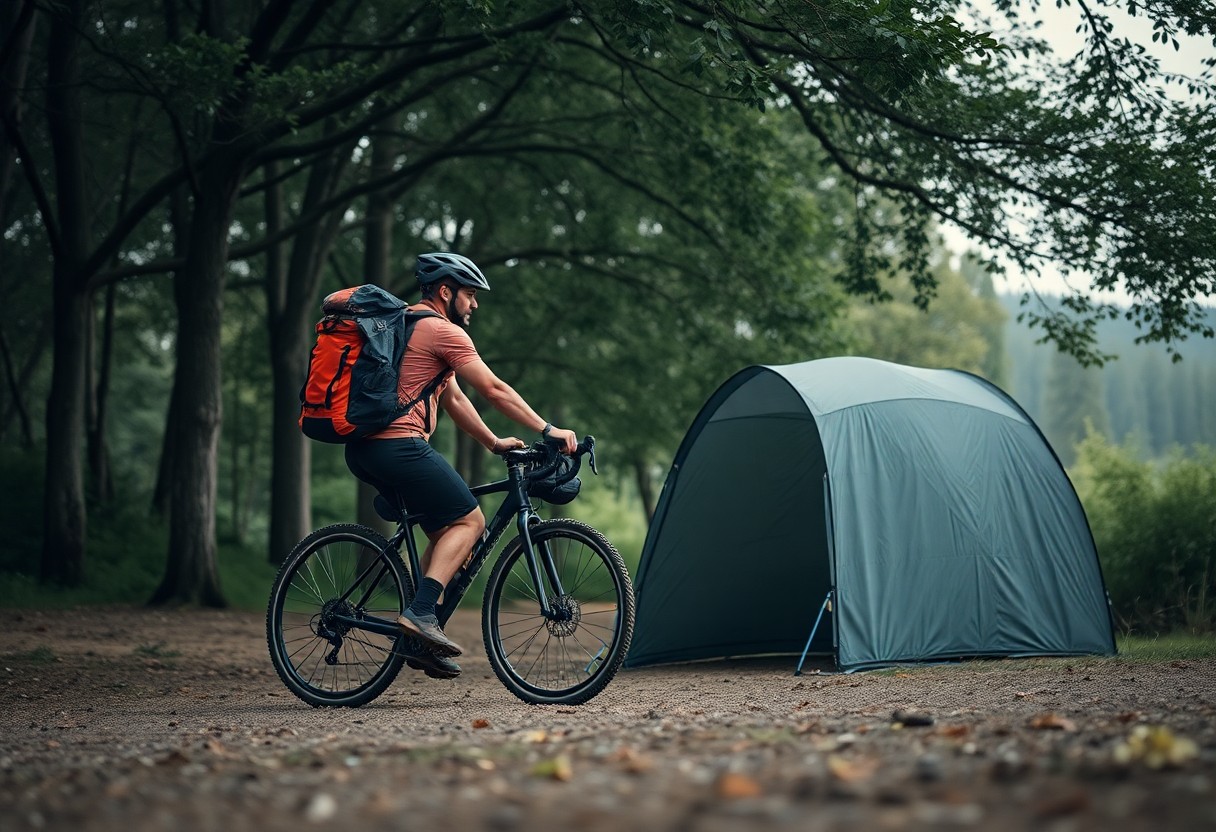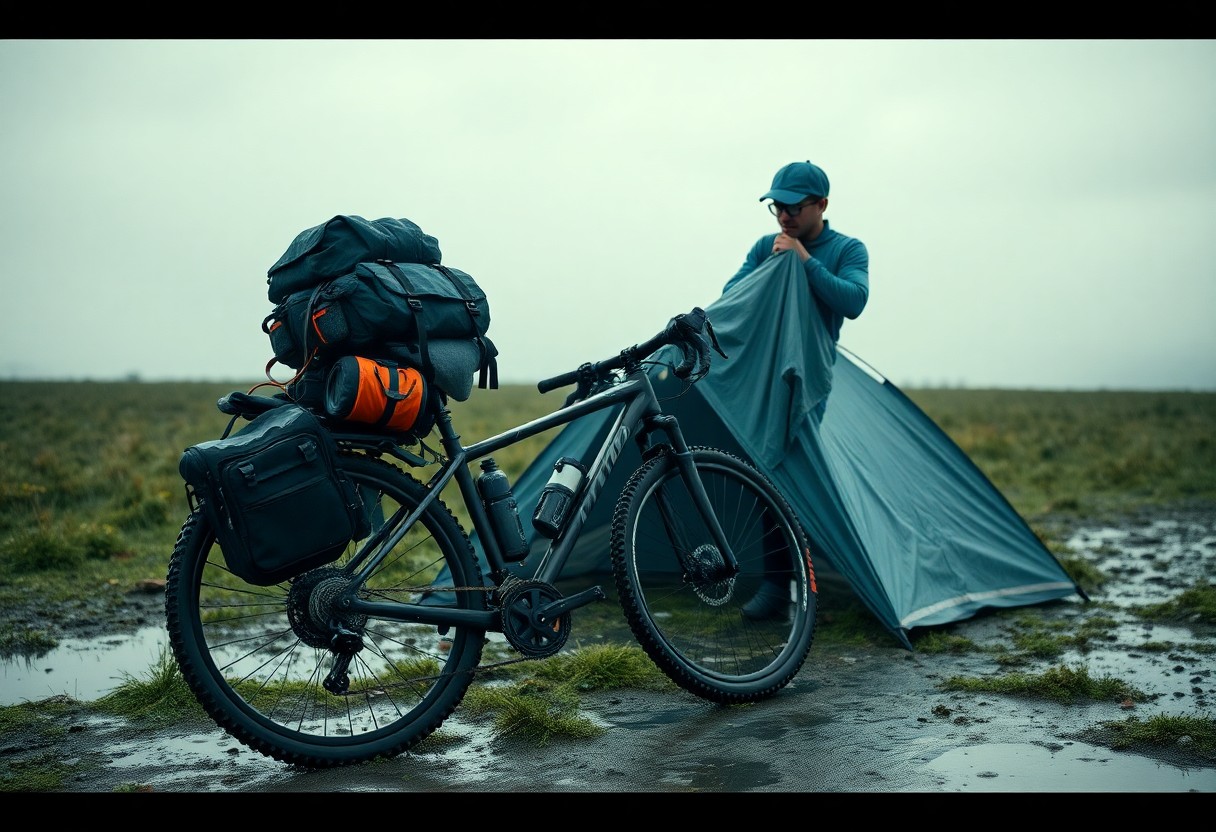There’s nothing worse than discovering your gear has been soaked during a bikepacking trip. To keep your items protected from rain and moisture, it’s vital to adopt effective strategies. From choosing the right waterproof bags to using dry sacks, every detail counts. In this post, you’ll learn practical tips and techniques to ensure your equipment remains dry, allowing you to focus on enjoying your adventure rather than worrying about your gear. Prepare for the elements so you can ride comfortably and confidently!
Key Takeaways:
- Utilise waterproof bags or dry sacks to keep your belongings protected from moisture during rain or river crossings.
- Invest in a good quality rain cover for your bike and bags to provide an extra layer of protection against the elements.
- Ensure all seams and zippers on your gear are sealed properly, and regularly check for wear and tear to maintain waterproof integrity.
The Imperative of Water Protection in Bikepacking
A bikepacking adventure often places you at the mercy of unpredictable weather. Protecting your gear from water damage is not just a precaution; it’s a necessity. Water can lead to ruined electronics, damp clothing, and compromised food supplies, ultimately ruining your experience. Keeping your belongings dry not only enhances your comfort but also ensures that your equipment remains functional throughout your journey.
Consequences of Gear Damage
Ignoring the need for proper water protection can have dire consequences. Items like electronics risk permanent damage, while clothing and sleeping gear may become soggy and unusable. This loss can disrupt your trip, forcing you to cut your adventure short or, in some cases, leading to safety hazards, especially in remote areas.
The Role of Weather Conditions
Adverse weather conditions can turn a pleasant ride into a treacherous ordeal. Sudden downpours, unexpected storms, or even prolonged humidity can wreak havoc on unprotected gear. For instance, temperatures dropping during rainfall can create condensation within bags, allowing moisture to seep into your belongings. Thus, being mindful of the forecast is just as vital as preparing your gear for the elements.
Weather can be notoriously unpredictable, especially in mountainous or coastal regions. A clear sky can quickly shift to dark clouds, and being caught unprepared can leave you vulnerable. Studies indicate that bikepackers who do not adequately protect their gear are at risk during over 70% of trips that encounter adverse conditions. Depending on your location, investing in waterproof gear and regularly monitoring weather updates can mean the difference between a safe, enjoyable trip and a serious setback.
Essential Gear Choices for Dry Adventures
Making the right gear choices can drastically reduce the risk of water damage to your belongings. Opt for high-quality waterproof bags and ensure your clothing is moisture-resistant. The right equipment not only keeps you dry, but also enhances your overall comfort during long rides and unpredictable conditions.
The Best Waterproof Bags and Cases
Investing in reliable waterproof bags and cases can save your gear from disastrous exposure to the elements. Look for bags that feature a rolled-top design and are made from robust materials like nylon or thermoplastic polyurethane. Brands like Ortlieb and Sea to Summit offer a range of dry sacks that not only keep water out but also withstand punctures and abrasions.
Choosing Moisture-Resistant Clothing
Your choice of clothing plays a pivotal role in staying dry. Look for garments made from wicking materials that allow moisture to evaporate while keeping your body insulated. Features like sealed seams and breathable fabrics are imperative for maintaining comfort.
Choosing moisture-resistant clothing goes beyond just water-resistant jackets. Invest in layers that effectively manage sweat and temperature, such as merino wool base layers and breathable waterproof outer shells. Ensuring that your outer layer is both waterproof and breathable is vital, as it prevents internal moisture buildup while shielding you from rain. Look for clothing with ventilation options, allowing for airflow during intense climbs. Brands like Gore-Tex and eVent specialise in fabrics that blend performance with protection, making them ideal for unpredictable bikepacking adventures.
Innovative Packing Techniques to Guard Against Moisture
Employing innovative packing techniques can significantly improve your odds of keeping your gear dry while bikepacking. Layering materials and utilising waterproof storage options, like compression sacks, can help manage space and provide additional protection. You might also consider using packing cubes that not only organise your belongings but can also be made from moisture-resistant materials, ensuring your necessarys stay safe from unexpected weather changes.
The Importance of Compartmentalisation
Compartmentalisation allows you to separate your gear into distinct sections, enhancing accessibility and protection from moisture. This approach helps to isolate items, meaning if one compartment gets wet, it doesn’t necessarily jeopardise your entire kit. By dividing your necessarys into smaller, waterproof sections, you’re more likely to keep important items, like electronics and clothing, dry and safe.
Compartmentalisation Techniques
| Technique | Description |
|---|---|
| Dry Bags | Store clothes or sleep systems in separate dry bags for added protection. |
| Packing Cubes | Employ packing cubes to compartmentalise various categories of gear for easy access. |
| Ziplock Bags | Use ziplock bags for smaller items like electronics or first aid kits to safeguard against moisture. |
Effective Sealing Strategies
Utilising effective sealing strategies ensures that your gear remains untouched by water. One reliable method is the use of silicone sealants on the seams of your bags, enhancing waterproof capabilities. For additional security, consider implementing roll-top closures, which can help create a watertight seal while allowing you to adjust the size of your bag according to your load. Moreover, opting for backpacks and panniers with weather-resistant zippers significantly diminishes moisture ingress, safeguarding your belongings throughout your adventure.

Mastering Trail Navigation to Minimise Wet Conditions
Effective trail navigation plays a vital role in avoiding wet conditions during your bikepacking adventures. By carefully selecting your routes and staying aware of your surroundings, you can significantly reduce your exposure to inclement weather. Familiarising yourself with local maps, using advanced navigation apps, and consulting recent weather reports will help you stay informed and steer clear of areas known for heavy rainfall or flooding. Being proactive in your planning not only enhances your experience but also helps maintain the dryness of your gear.
Recognising Weather Patterns
Understanding the local weather patterns is fundamental to remaining dry on your bikepacking trip. By paying attention to the seasons and typical climate behaviour of your chosen region, you can make informed decisions about the best times to set off. Monitoring cloud formations and wind direction can also provide valuable insights; for instance, darkening clouds often signal impending rain, allowing you to adjust your route or take shelter.
Identifying Shelter Options Along Your Route
Identifying potential shelter options along your route can offer peace of mind, providing a refuge in adverse weather. Familiarise yourself with both natural shelters, such as overhanging rocks or dense tree canopies, and human-made offerings, including campsites and local inns. A comprehensive plan that details these options will prove invaluable, especially in regions prone to sudden showers or prolonged downpours, ensuring you can protect yourself and your gear when necessary.
Inserting planned stops for shelter allows you to break up your journey while staying dry. Consider examining maps for picnic areas, visitor centres, and even local cafes that welcome cyclists. Researching these locations in advance can save you a great deal of trouble if the weather takes a turn. Equally, utilising mobile apps that provide real-time updates on nearby facilities can also bolster your preparedness during your adventure.
Emergency Preparedness: Battling the Unexpected
Anticipating the unpredictable is key to bikepacking success. Sudden changes in weather or on-trail challenges can catch even the most seasoned travellers off guard. Equip yourself with necessary knowledge and gear to respond swiftly when these moments arise, ensuring that your journey remains enjoyable. Adaptability and readiness will transform potential mishaps into mere inconveniences.
Quick-Dry Solutions for Sudden Rain
Having quick-dry solutions on hand for unexpected downpours can prove invaluable. Look for clothing made from fabric technology that wicks moisture away and dries rapidly, such as synthetic blends or merino wool. Additionally, consider carrying a lightweight, packable rain jacket that allows you immediate shelter without compromising space on your bike.
Essential Repair Kits for Water-Related Incidents
Water-related incidents can lead to unexpected challenges if you are not prepared. An effective repair kit should include waterproof tape, multi-tools, and spare bike tubes that can withstand wet conditions. Don’t overlook including sealant for puncture repairs and waterproof gloves to keep your hands dry during repairs, ensuring you stay resilient against the elements.
Include items such as a small pump with a flexible hose, which allows for easy access to valves even in rainy conditions. A portable charger is also beneficial; should your electronic navigation fail due to water exposure, you won’t be left stranded. An emergency blanket can provide warmth and shelter as well, protecting you and your gear until conditions improve, ensuring that you remain prepared for whatever nature throws your way.
Conclusion
As a reminder, keeping your gear dry during bikepacking adventures is vital for your comfort and safety. Make sure to invest in high-quality waterproof bags and utilise dry sacks for sensitive items. Regularly check your gear for wear and tear, and consider using additional waterproof covers for extra protection. Lastly, plan your route to avoid prolonged exposure to heavy rain, and always have a contingency plan. By taking these steps, you’ll ensure that your possessions stay safe and dry, allowing you to fully enjoy your biking experience.
FAQ
Q: What are the best materials for waterproof bikepacking bags?
A: When deciding on bikepacking bags, consider materials such as nylon with a waterproof coating, PVC tarpaulin, or any bag designed specifically for wet weather. Look for bags that feature welded seams and waterproof zippers, as these will provide additional protection against moisture. It is also advisable to invest in dry bags or inner liners, which can offer an extra layer of defence against unexpected showers.
Q: How can I protect my electronics from moisture while bikepacking?
A: To keep your electronics safe from moisture, use waterproof cases or pouches designed for electronic devices. You can also place items like smartphones, GPS devices, and cameras inside zip-lock bags before placing them in your bikepacking bags. Additionally, avoid storing electronics in your outer pockets, as these are more vulnerable to exposure. If possible, pack them in the middle of your gear, surrounded by other items for added cushioning against the elements.
Q: What strategies can I adopt to keep my gear dry during unexpected rain?
A: In the event of unexpected rain, there are several strategies you can employ to keep your gear dry. Firstly, consider carrying a pack cover that fits over your bikepacking bag, which can help repel water. Secondly, position the most important items, such as your sleeping bag and clothing, in the middle of your bag and use dry bags for added protection. Lastly, adjust your route to seek shelter during heavy rainfall, and have a plan to set up camp in a dry area if necessary. It is also advantageous to keep an eye on the weather forecast before launching on your trip.
